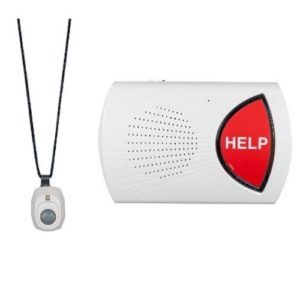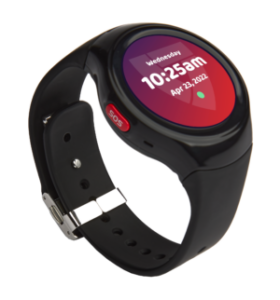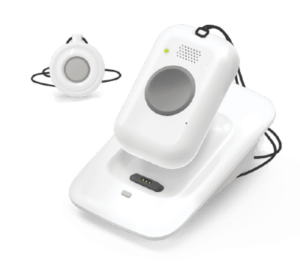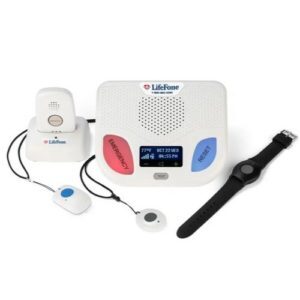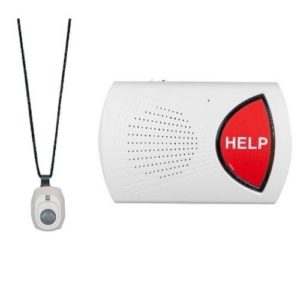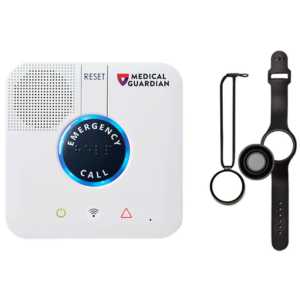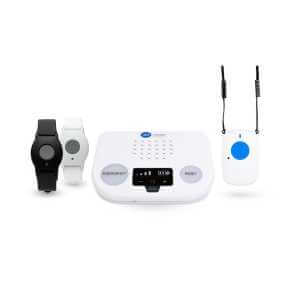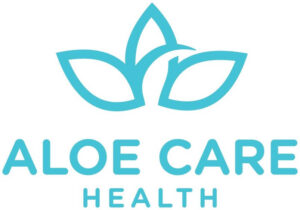We tested products and talked to a medical professional to whittle down a list of over 70 medical alerts to pick Bay Alarm Medical as the best overall medical alert system.
Best Medical Alert Systems 2025
*Medical Alert monthly payment plans start at $27.95/mo. If you pay for an annual plan, it works out to $19.95/mo. LifeFone $29.95/mo. if paid monthly; $24.95/mo. if paid annually.
For over 11 years, SafeWise experts have conducted independent research and testing to write unbiased, human reviews (not robots). Learn more.
Cathy, a Safe Sleep Ambassador, specializes in family safety, simplifying complex topics for trusted sites like Safety.com with 8+ years of writing experience.
Almost 319,000 older people are hospitalized for hip fractures each year1.Medical alert systems provide fast, easy access to emergency help with the press of a button. They're particularly important for people who live alone and are older than 65—the milestone age when the risk of heart attack, stroke, dementia, and falls starts to increase significantly.
All medical alert devices include a wearable help button, and some also include GPS tracking and automatic fall detection for extra protection. These devices—also called personalized emergency response systems (PERS)—share a lot of features from brand to brand.
To help you choose the right medical alert, we reviewed the differences between each and conducted hands-on testing. Only the most reliable and user-friendly brands made it onto our best medical alert systems list. We've named Bay Alarm Medical the best-of-the-best, but we encourage you to read through the entire list to find your perfect match.
What is an emergency pendant?
An emergency pendant (also called a panic button, help button or medical alert) is a small, portable, battery-operated device that will contact help in an emergency. Most emergency pendants are worn around your neck, on a watch, or clipped onto a belt.
Emergency pendants are connected to a home security or medical alert company monitoring professional. When the button is pushed and held during an emergency, the monitoring professional will communicate through the system's base station or control panel to assess the situation and call for help from emergency services or a personal contact list, as needed.
What are the best medical alert systems in 2025?
- : Best overall
- : Best wearable devices
- : Best fall detection
- : Best at-home system
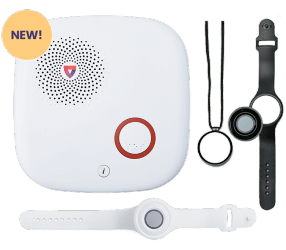
🔥 Bay Alarm Medical is offering up to 50% off, free shipping, and a free month on select plans.
🔥 Medical Guardian: Get 75% off the MGMini. Plus get FREE Shipping, 1 FREE month and FREE lock box.* Use code: LIGHTNING75
🔥 ADT Medical: Get $5 off monthly monitoring + free 2-day shipping + free lockbox.
🔥 AngelSense is currently offering a FREE kids GPS tracking device (regularly $229) when you sign up for a month-to-month or annual service plan!
🔥 LifeFone is currently offering one free month + free shipping.
🔥GetSafe: Get 30% off and free shipping on alert systems.
Info current as of publish date. Offers and availability may vary by location and are subject to change.
* Offer valid for Annual subscriptions by new customers only.
**Requires a month-to-month agreement. Excludes taxes. First month monitoring due at time of purchase. For additional details, click here.
Based on our research, 96% of people looking for a medical alert are worried about falls, 82% prefer to shop online, and 48% need something affordable2. That's why we recommend Bay Alarm Medical as a top choice.
Bay Alarm offers low monthly prices, a respectable in-home signal range and 32 hours of backup battery power. And 32 hours of backup is the norm for these medical alert systems. Just Medical Alert is a little less at 30 hours. All of the systems have a landline option, though.
Video: What to look for in a medical alert system
Subscribe to our YouTube channel and protect your home, loved ones, and belongings.
What features should I look for when choosing a medical alert?
Ease of use is one of the most important factors to consider when choosing a medical alert system. According to health expert Sally Russell, MN, CMSRN, CNE, "There shouldn't be any numbers to dial, just a big button." That button should also be easy to feel or to see without your glasses.
Sally also notes that mobile and wearable buttons should be discreet enough to hide under a shirt or tuck into a pocket. "People don't want everyone to know that they're wearing a help button when they go out in public," she notes.
Your medical alert should give you confidence and help you enjoy more independence. Choose one that you'll be comfortable using and wearing.
Read our complete guide to choosing a medical alert for an explanation of common features and the people who benefit from them most.
Is there a cheaper alternative to Life Alert?
A lot of folks look up Life Alert because it’s the only medical alert brand they know of, and then they’re turned off by the high price. MobileHelp is one of the most affordable options if a budget-friendly help button is what you're after.
1. Bay Alarm Medical: Best overall
Bay Alarm Medical balances quality, variety, and affordability like no other medical alert company. Whether you're looking for an accurate GPS medical alert, a fashionable alert necklace, or a medical alert system with a long-lasting battery, Bay Alarm Medical has what you need—and at a great price to boot.
We also like Bay Alarm Medical because it's one of the few medical alert brands to offer a price lock guarantee with no strings attached. Plus, its monitoring center boasts the industry’s four most prestigious certifications and offers support in around 170 languages.
You can get our full opinion in our detailed Bay Alarm Medical review.
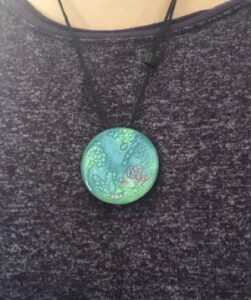
Image: Cathy Habas, SafeWise
We tested all of Bay Alarm Medical's equipment before we made it our top recommendation. Everything was a breeze to set up and use, right down to the caregiver app.
We especially loved the Bella Charms, which cover the emergency pendant and give you a beautiful incentive to wear it everyday.
Video: Bay Alarm Medical review
2. Medical Guardian: Best on the go
Medical Guardian makes our favorite mobile medical alert systems. We like the MGMini because it uses GPS tracking technology, cellular data, and Wi-Fi to pinpoint your location in an emergency—making it a perfect on-the-go option.
It's also compatible with the MyGuardian mobile app, boasts a 5-day battery, and can be upgraded to include automatic fall detection for an extra monthly fee.
Learn more in our full review of Medical Guardian.
Many other brands rely on just GPS data for location tracking. Because there’s more than one technology at work in the MGMini, it’s more likely to transmit an accurate location to caregivers or the monitoring center.
The MGMini comes with a lanyard and belt clip, and its battery lasts up to five days. You can add a built-in fall-detection sensor to this mobile medical alert system for an extra $10 a month.
You should consider a mobile medical alert device if you leave home by yourself. In-home systems don't work once the wearable button is too far away from the base station, but mobile alert devices work anywhere there's good cell coverage.
Learn more about the different types of medical alerts.
Free caregiver app
We also like the MyGuardian app and online dashboard, which lets your loved ones and caregivers see where you’ve been and where you are now. You have full control over who gets this information.
Other medical alert companies have no caregiver portal, make you pay extra for one, or only give location information through text.
MyGuardian also lets your loved ones keep an eye on the MGMini’s battery or pay your monthly bill.
Check out our Medical Guardian product guide for more details.
Take a closer look at the similarities and differences between our two favorite medical alert companies: Bay Alarm Medical vs. Medical Guardian.
3. Medical Alert: Best for fall detection
Medical Alert's Mobile System uses more fall detection sensors than most other systems: an accelerometer, gyroscope, and barometric pressure sensor. We found Medical Alert’s representatives to be the most knowledgeable, which goes a long way whether you're shopping around or calling for help.
You can find a better deal for a mobile system (and fall alerts is an extra $10 per month), but we can't ignore the superior fall detection sensors in the pricier Mobile System.
Medical Alert's three sensors are a rarity
The more sensors in a device, the more accurately it detects falls. Out of more than 75 devices we considered, only three had dual fall-detection sensors—and only Medical Alert had three.
The data from all three sensors is cross-referenced, which reduces false alarms and improves fall alert accuracy. While this technology blows away the competition, you still need to recognize—as with all automatic fall detection technology—that you're not guaranteed 100% accuracy.
Medical Alert's equipment
Overall, Medical Alert’s equipment is pretty basic. The in-home systems come with the usual base station and a waterproof help button you can wear with a lanyard or wristband. The mobile GPS system has a docking station and a removable, wearable base unit plus an extra wearable button.
One nice feature is that when the help button batteries get low, the device sends an alert to the monitoring center and Medical Alert ships a free replacement.
But there aren't any fancy extras (after the fall detection) and there's no option for voice control. Overall, we recommend Medical Alert's mobile system with fall detection, especially if you’re active outside the home but want the reassurance of advanced fall detection tech.
Get all the details in our complete Medical Alert review.
A fall detection device is just one part of a senior safety plan. Read our guides for more information:
4. LifeFone: Best at-home medical alert system
We like LifeFone’s in-home medical alarm systems because you can add extra layers of protection with inactivity alerts, daily check-ins, or fire and smoke monitoring.
And Lifefone’s wearable devices work up to 1,300 feet away from the base station—one of the longest ranges on the market. That means most folks can go out in the yard without switching to a mobile device.
LifeFone monitors all system batteries and sends you replacement devices when the battery gets low (which takes about five years). The wearable pendants can double as a phone receiver, allowing you to answer all incoming calls anywhere in the house or yard, and the base units monitor indoor temperature.
LifeFone extras
LifeFone’s extra features provide a fail-safe for people at risk of passing out or being unable to push the help button.
- Fall detection starts at $5/month
- Activity assurance for $6/month
- Daily check-in calls for $19/month
Learn more in our full LifeFone review.
5. ADT Medical Alert: Most trusted name
You probably know about ADT’s home security systems, but ADT also sells and monitors medical alert systems. And if you already have an ADT security system, you can get discounts on a medical alert device for loved ones. ADT Medical Alert is also one of the few systems you can snag with a price lock guarantee—definitely a big deal if you rely on limited income like social security.
ADT Medical Alert offers temperature monitoring
Both ADT Medical Alert Basic and ADT Medical Alert Plus monitor ambient temperature. This feature alerts you to temperatures that are too hot or too cold—a very important thing to watch as older people are more at risk of complications from the dangers of extreme temperatures.
Learn more about ADT Medical Alert in our full review.
6. MobileHelp: Best basic system
MobileHelp is great for a basic push-button medical alert system and boasts the longest signal range in the industry at 1,400 feet. Although MobileHelp’s starter price is technically the most affordable on our list, adding a fall-detection pendant, wall buttons, medication reminders, or spouse coverage to your MobileHelp order makes it cost about the same as competitors like Bay Alarm or LifeFone.
Read our full review of the most affordable medical alert systems for more details.
Unique service: MDLive
All MobileHelp subscribers have access to a telehealth service called MDLive. MDLive allows you to speak to a doctor on demand. They can prescribe common medications, ensuring a small problem doesn’t turn into a big deal. You don’t pay a co-pay or even have to verify your insurance.
Learn more in our full review of MobileHelp.
7. Aloe Care Health: Best smart features
In addition to the usual help button and two-way talk, Aloe Care Health’s base station monitors air quality, temperature, and motion. You can also call for help by repeatedly saying “Emergency” or use the hub as a speaker phone to call your caregivers.
And if all of that isn’t innovative enough, Aloe Care also offers a totally unique wall-mounted fall detection hub designed for bathroom safety, where the risk of falling is especially high as you get out of the tub or shower—according to the CDC.
We also like that Aloe Care sells extra motion sensors that offer a second layer of protection. The sensors learn your typical routine and alert caregivers if you aren’t active at your usual times.
Great for caregivers
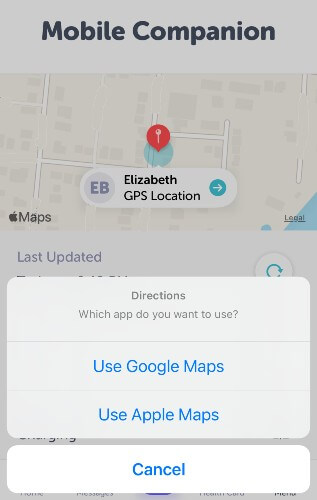
Screenshot: Cathy Habas, SafeWise
We think Aloe Care’s caregiver app is one of the easiest to use and offers the most comprehensive insights. Caregivers can download the Aloe Care app and place calls directly to the base station for quick check-ins. They’re also welcome to call the monitoring center if they’re concerned about your well-being.
The app also lets loved ones know you’re up and moving based on what the equipment senses. If too much time passes without motion, they’ll know it’s time to check-in and make sure you’re okay.
A couple of flaws
Aloe Care does have a few kinks to work out like the base station backup battery—it lasts just six hours, which is way behind the 32-hour life of many other brands.
In addition, Aloe Care’s wearable button has the smallest range we encountered, so you can’t really wear it into the yard. You’ll have to grab the mobile unit on your way out.
Learn more about our testing experience in our full review of Aloe Care Health. Or compare it to another voice-activated system in our GetSafe vs. Aloe Care Health head-to-head review.
Video: Aloe Care Health review
8. Lifenet: Best customer policies
We found only one medical alert company that didn’t charge hidden or extra fees: Lifenet. With this medical alert company, you won’t get hit with activation, restocking, or cancelation fees. You don’t even have to pay shipping on orders or returns.
Lifenet also offers a free lifetime warranty on all equipment. Many other companies will charge you for the price of lost or damaged equipment—which can easily cost over $300—or make you pay for an extended warranty.
We also like these Lifenet policies and services:
- Prorated refunds
- Batteries monitored and replaced by the company
- Affordable spouse coverage ($3.99/mo.)
Lifenet equipment and cost
Lifenet sells two equipment packages: Home and Garden, and Home and Away.
Home and Garden is an in-home system. Its base unit connects to a landline, and you wear a wristband with a button on it. The button works within about 1,000 feet of the base station so you can go out into the yard and know that help is still a push away. It costs $29.95 per month, and you can add wall buttons for an additional $2.49 a month each.
Home and Away is a wearable medical alert device. It includes a help button, a speaker, and a microphone so you don’t have to stay near a base station to ask for help. This waterproof device also detects falls and features GPS technology so helpers can know where to find you if you get lost. The Home and Away costs $49.95 per month.
The only extra service offered by Lifenet is a “daily assurance” check-in. A Lifenet representative speaks to you every day, and they send help if you don’t respond.
More medical alert brands we considered
We considered more than 75 products across nearly 30 brands. Here are a few that didn’t quite make the cut.
9. Medical Care Alert
Medical Care Alert offers similar equipment to Bay Alarm but costs around $5 to $7 more each month. We also found its website a little confusing because there’s no way to easily see its full product lineup.
It’s worth mentioning that Medical Care Alert used to offer a fall detection device with the holy trinity of sensors: an accelerometer, gyroscope, and magnetometer. This product was discontinued because it relied on the now-defunct 3G cellular network.
If Medical Care Alert releases this device again with 4G or 5G cellular service, we’ll sit up and pay attention. But for now, we think other brands offer better value.
10. Philips Lifeline
We like Philips Lifeline as a "runner-up" for the best fall detection system. Combining an accelerometer and barometric pressure sensor, the Lifeline AutoAlert accurately detects about 95% of falls. You can get this fall detection device as part of an in-home or on-the-go system to suit your lifestyle. We’re also impressed by Lifeline’s transparency and commitment to fall-detection education.
Learn more in our full Philips Lifeline review.
11. Get Safe
GetSafe, a branch of Bay Alarm Medical, is the only medical alert company that charges a flat rate for monitoring—$27.95—no matter how many buttons you want in your home. (GetSafe recommends one button for each room in your home for best results.) Other companies charge an extra monthly fee for every button.
But GetSafe is also one of the only companies that requires you to pay an upfront equipment fee, which can be challenging for some.
Learn more in our full GetSafe review.
12. LifeStation
LifeStation deserves a shout-out as the only other medical alert company besides Lifeline to combine an accelerometer and a barometric sensor in its fall detection device. LifeStation’s basic in-home package starts at $32 per month, but GPS tracking, fall detection, wall buttons, spouse coverage, and a warranty all add to the monthly fee.
Learn more in our full review of LifeStation.
13. Lively (formerly Great Call)
The Lively Wearable 2 has been discontinued, but it was never our favorite medical alert device to begin with since it didn't include a built-in speaker—you needed a smartphone nearby for it to be useful
The Lively Mobile Plus is still available. There’s really nothing wrong with this product—we just prefer the extra tracking technology in the Medical Guardian Mini Guardian and the superior fall detection technology in the Lifeline AutoAlert.
Lively also partnered up with some big names in the tech industry. It's now the professional monitoring option for Apple Watches and Alexa Together. Although it can get pricey, Lively's concierge services are worth looking into.
Learn more in our full Lively review.
14. BellPal with BlueStar SeniorTech
Our hearts definitely went pitter-patter when we saw this gorgeous medical alert watch. The BellPal doesn’t look like a medical alert device at all, but it includes GPS tracking, fall detection, and an SOS button. Like the Lively Wearable 2, BellPal only works when it’s close to a smartphone.
We were also bummed to see that you have to take this watch to a jeweler every four to six months to replace the battery. We know “replace battery” would end up on our to-do list for weeks. That’s why many other companies just send you a new wearable device instead of asking you to do it yourself.
BellPal costs about $200 up front. Monitoring is provided through BlueStar SeniorTech starting at around $20 a month.
15. Life Alert
Life Alert is an industry pioneer famous for its TV commercials, but it hasn’t moved its sales and marketing into the 21st century. There’s almost no information about the system online.
We called to discover the cost of Life Alert. It’s by far the most expensive medical alarm system on the market, with monitoring prices starting at nearly $50/month. The minimum activation fee is around $95. The price significantly increases if you add a GPS button, and there’s no automatic fall detection option at all.
Learn more in our full Life Alert review or check out our recommended Life Alert alternatives.
With an AARP membership, you can get a 15% discount on a Lifeline medical alert system, in addition to discounts on hotels, restaurants, prescriptions and more. You also get the AARP magazine, access to virtual learning programs, and can connect with other AARP members in your community.
16. QMedic
QMedic offers a cellular in-home system and a mobile GPS button. This company lost our interest once we found out it doesn’t offer any fall detection at all. It’s also the only company we found that requires a full year of payment up front.
17. FastHelp
FastHelp is not a monitored medical alert system, so we don’t recommend it for most situations.
Because it always calls 911 directly, you may get fined for false alarms. The 911 dispatchers and emergency responders also won’t have your medical history, lockbox code, or emergency contacts on file. In contrast, monitored systems retain this information and relay it to the emergency service for fast, accurate, and safe help.
The main advantage of FastHelp is that you only pay a one-time equipment fee. Since there’s no emergency monitoring, there are no monthly fees.
Learn more in our full FastHelp review.
Final word: Bay Alarm Medical is the best medical alert system
We like Bay Alarm Medical best overall because it covers all the bases at a competitive price. But every person and situation is a little different, so you might prefer the price, tech, or policies of another company. The key is to find a device that makes you feel confident and independent.
Medical alert system FAQ
Medical alert systems cost anywhere from $20 to $70 per month on average, but there are some up-front fees you'll need to budget for too.
- Equipment fees are more common with mobile medical devices and average between $50 and $200.
- Activation fees are rare but typically range from $35 to $100.
- Installation fees are even rarer—watch out for this $20 to $100 charge from Lifeline.
- Shipping fees depend on your location but usually run between $10 and $20.
Medical alerts aren't covered by Medicare in most circumstances.
To learn more about possible hidden fees and how to keep costs low, read our guide to choosing a medical alert system.
AARP doesn't officially recommend one medical alert over another. That said, there's only one medical alert discount available to AARP members: 15% off Lifeline medical alert systems.
An at-home medical alert system has a wearable button that connects to a base station. A GPS medical alert system also has a wearable device, like a watch, but doesn't need a base station to work. Either system connects you to a trained operator who will contact emergency services or a family contact in the event of a fall or other emergency.
Watch our video below to find out more.
Your kids, friends, or neighbors might like to have a caregiver app that lets them check in on you without being too nosy or nagging. Once you get back to feeling like your independent self, you’ll probably prefer that too.
The exact features depend on the company, but most caregiver apps let your loved ones see where you are, whether your device’s battery needs charging, and whether you pushed the help button.
Monitored medical alert systems connect you to a call center instead of 911. There are several advantages to this:
- You won't get fined for false alarms.
- The monitoring center can reach out to your loved ones or other caregivers if needed.
- The monitoring center has your medical information on file and can relay it to 911 dispatch. You might not feel well enough to give first responders this information yourself.
- The monitoring center knows your lockbox code and can give it to 911 dispatchers. This allows the emergency responder to quickly open your door with a key rather than having to kick it in.
A medical ID bracelet provides important medical information to first responders once they're at your side. A medical alert system is what summons them in the first place.
Medical alert systems are a big help for people (usually seniors) who live alone but are at risk of emergency health complications. But, we get it—these devices feel a little undignified at first. (I felt the same way about getting my CPAP!)
It's not fun to think about, but consider this: you may not be able to see, move, or think well enough to dial 911 on your phone in an emergency, or to speak clearly enough to tell them where you are.
A medical alert is a one-push solution. If you need one, you need one.
You could move in with family or hire an in-home caregiver to make sure someone else can dial emergency services for you. But getting a medical alert system is the easier and more affordable option. Plus, you get to stay in your own home and maintain some privacy.
Read answers to more senior safety FAQs.
How we reviewed the best medical alert systems
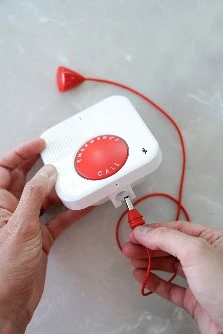
Image: Anastasia Hrivnak, SafeWise
- 76 products considered
- 44 data points compared
- 7 products tested
- 2 weeks of product research
To prepare our medical alert system review, we compared each product’s technical specifications, talked to brand representatives, spoke with users, interviewed our advisory board member Sally Russell (MN, CMSRN, CNE, Health Expert and Educator), read scientific papers about the latest fall detection technology, and tested products hands-on.
Our proprietary weighted ranking system focuses on these categories:
- In-home tech specs and costs
- In-home equipment options
- Mobile device specs and costs
- Caregiving features
- Hands-on testing performance
- Company policies and attributes
We compared each medical alert company's lowest monthly cost for an in-home cellular system. We didn't compare landline prices, because some companies don't offer landline-compatible equipment. However, we did take into consideration whether a landline option was offered.
We also compared the lowest equipment fees, regardless of whether it was available as a landline or cellular system. Rounding out the in-home cost comparison was our analysis of hidden or extra fees, such as activation or installation fees.
We also considered backup battery life, maximum signal range, and more. And we investigated whether each company monitors and replaces their help button batteries for free.
We prefer seeing more equipment options since this allows people to make custom packages that suit their needs. We also looked at the cost of each option, preferring one-time fees over monthly fees for long-term affordability.
Some of the in-home equipment options we evaluated included fall detection, voice activation, wall buttons, jewelry pendants, and accessories like a lockbox or Vial of Life.
Because mobile devices often feature more technology than in-home devices, we scored them separately.
For this category, we considered the lowest equipment costs and monthly costs, plus the maximum battery life. We preferred standalone devices that aren't dependent on a smartphone, and we liked seeing more than one wear option (such as a belt clip).
We also compared the number and type of fall detection sensors (tri-axial accelerometers, barometric pressure sensors, magnetometers, and gyroscope) and location technologies (GPS, Wi-Fi, and 4G).
Caregiving features were also considered in our medical alert rankings but given less weight than other categories because medical alert systems still work without these features.
We looked for smartphone apps or online portals geared toward caregivers and considered the cost of these tools. We preferred systems with location tracking and battery alerts on the app, plus medication reminders and inactivity alerts.
We compared each medical alert brand across 13 policies and attributes. For example, we considered warranties and trial periods, price lock guarantees, the cost of spouse coverage, cancellation penalties, and whether the monitoring center is Five Diamond certified.
Hands-on testing performance
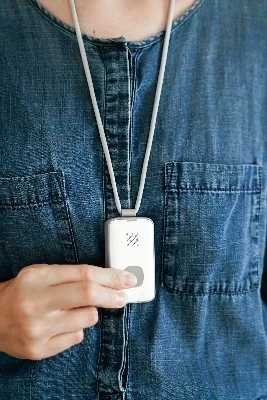
Image: Anastasia Hrivnak, SafeWise
We were able to test products from Bay Alarm Medical, GetSafe, and Aloe Care for this review, giving us extra insight into how each medical alert device performs in real-world situations.
For example, we placed multiple test calls to the professional monitoring centers to evaluate audio quality, answer speed, and ease of use. We also tested mobile medical alerts' GPS location accuracy, battery life, and caregiver app ease of use.
Learn more about our methodology.
Sources
- Moreland B, Legha J, Thomas K, Burns ER, Journal of Aging and Health, "Hip Fracture-related Emergency Department Visits, Hospitalizations, and Deaths by Mechanism of Injury Among Adults Aged 65 and Older, United States 2019," June 2023. Accessed December 15, 2024.
Recent Articles




